Before the lesson:
1. Complete all conductivity tests ahead of time.
2. For the exploration activity, decide whether to prepare cups of liquid ahead of time or let students set up cups as part of the lesson. Students will test the following liquids but other liquids can be used such as soda and vinegar.
• 150 ml water
• 150 ml water and 1 tbsp. salt
• 150 ml water and 1 tbsp. sugar
• 150 ml Gatorade
• 150 ml chocolate milk
• 150 ml orange juice
3. Keep extra bulbs and batteries on hand.
4. If not using alligator clips, cut 8-10 inch pieces of wire and the strip the ends.soda and vinegar.
Engage:
1. Introduce the mystery:
A student at the school science fair created a complete circuit using all of the following materials: bulb, wires, battery, and liquid. How is this possible?
2. Allow students time to discuss and share their ideas with the class.
3. Before we begin we need to make sure we know what complete circuits are. Give each group a bulb, bulb holder, 9-volt battery, battery holder, and two alligator clips. Challenge students to create a circuit that will make the bulb light. Ask students to demonstrate and explain
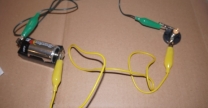
4. Move around the room to allow students to demonstrate and explain their circuits. This will help students who are having trouble successfully connecting the components. Work with groups to help as needed. Ask and discuss:
- How do you connect each part to make the system work? Connect a wire to the negative terminal of the battery to one side of the bulb holder. Connect a wire to the positive terminal of the battery to the other side of the bulb holder.
- What happens when you remove a wire, or open the circuit? The bulb will not light.
- What happens when you connect all of the wires, or close the circuit? The bulb will light.
- What kinds of conductors can you place in the circuit path? Students can place a penny, paperclip, or other metal object.
- What is a conductor? a material such as copper and aluminum that electric current can pass through easily
- What do you call materials that do not allow electricity to flow through? Insulator
5. Spend just enough time on this step to review insulators and conductors and ensure that students know the difference.
6. Ask if students if they think they can conduct electricity with anything else. Make a list of students’ ideas. Be sure to include liquids on the list. Ask students for suggestions on how to test their ideas.
Explore:
1. Ask students if they think it is possible for liquids to conduct electricity. Students explain their thinking.
2. Explain that students will test liquids to see if they can conduct electricity. In order to do so students will need to modify their circuit to create a conductivity tester.
3. Give each group two large paperclips, two small pieces of aluminum foil. Instruct students to wrap foil around each paperclip so that it is completely covered.
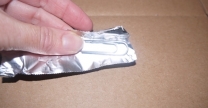
4. Clip the aluminum covered paperclips (paddles) to the end of the wires or alligator clips. The paddles will serve as conductivity testers.
- Why do we need to make a special testing device? We do not want to get the clips or wires wet, so we need to make something that we can place in each liquid.
5. Students confirm that their tester works by touching their conductivity tester paddles together to light the bulb.
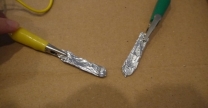
6. Students prepare liquids for testing. (Liquids may be set up in advance.) Give each group six plastic cups. Students label and fill the cups containing the following:
- Cup A - 150 ml water
- Cup B - 150 ml water and 1 tbsp. salt
- Cup C - 150 ml water and 1 tbsp. sugar
- Cup D - 150 ml Gatorade
- Cup E - 150 ml chocolate milk
- Cup F - 150 ml orange juice
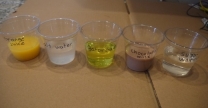
7. Students predict whether each liquid will conduct electricity using their record sheet.
- What do we call liquids that contain more than one ingredient? Mixtures
- Since you cannot see the individual ingredients in each cup, what do you call this type of mixture? solution
8. Students place the tips of their testers inside each cup and then observe what happens. Students record observations on their Electrical Liquids Results page.
9. Demonstrate how to wipe off the testers after testing each liquid.
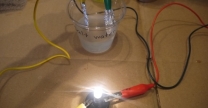
10. Instruct students NOT to touch the tester paddles together once they are placed in each liquid. This will result in inaccurate results. Ask:
- What happens when you move the paddles closer together and further apart? Students will notice that the light will dim when the paddles move further away from each other and will become brighter when they move closer together.
- How is it possible for liquid to conduct electricity? Students share their ideas. Write them on the board.
Explain
Each group will share and compare their results.
- Which liquids conducted electricity? Salt water, chocolate milk, and Gatorade are solutions that will conduct electricity using the set up described in the lesson. If a lower voltage battery is used, the chocolate milk and Gatorade may not be able to conduct enough electricity to light the bulb.
- Why did those solutions conduct electricity? Students need to think about what they might contain. Students can compare ingredients using the product labels. The salt water and chocolate milk contain a great deal of salt. The bulb lights with saltwater and chocolate milk because the salt acts like an invisible wire to connect the circuit. When you add salt to a liquid like water, the salt molecules dissolve in the liquid and break into smaller parts called ions. The ions carry electricity through the liquid. Acids and bases also break down to form ions when dissolved in water. The Gatorade is an example that contains electrolytes that also produce ions.
- Which solution helped produce the brightest light? the dimmest light? Answers may vary depending on how close students held their tester straws together. Students may find the saltwater to be the brightest and the Gatorade to be the dimmest. Answers may vary between groups. Discuss why this might happen and have students demonstrate how they tested each liquid.
- What safety issues are related to this activity? This activity should be conducted with an adult. Never place electrical appliances in water. With enough voltage water will conduct an electrical current. All water with the exception of pure water, will conduct electricity because it contains ions that conduct the current. This is why people never swim during an electrical storm.
Elaborate
1. Since we can test whether a liquid contains salt using an electric circuit, ask
- Is it possible to remove the salt from the solution? Some students may suggest heating the water.
- If so, how will we know that the salt is gone? We can use the conductor tester to see if any salt remains.
2. Give each group a bowl, cup of salt water, plastic wrap, and a small heavy object such as a rock.
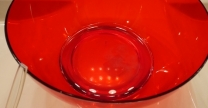
3. Students test their salt water to make sure that it conducts electricity.
- Then pour the salt water into the bowl.
- Place the empty cup in the center of the bowl.
- Cover the bowl with plastic wrap.
- Place a small heavy object such as a rock or washer in the middle of the plastic wrap above the empty cup. The plastic should slope downward.
4. When the water evaporates it will condense onto the plastic and move downward toward the cup. Then the water will drip into the cup.
5. Place the bowl under a heat lamp or outside in bright sunlight. Wait for the water to evaporate. Then ask:
- What do you notice in the cup? Water will evaporate, condense on the plastic, and then drip into the cup.
- Do you think there is salt inside the cup? Salt does not evaporate so only water will be in the cup.
- How can we be sure? Test the cup using the conductivity tester.
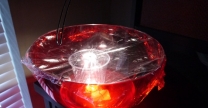
6. Students test the cup of water to confirm that it no longer contains salt.
7. Introduce the term desalination plant. This is a system that removes as much salt as possible from water. Ask:
- How can a desalination plant be beneficial? A water desalination plant is a system that takes in saltwater and produces clean drinking water. A saltwater circuit could be used as a tool to detect the presence of salt. If the saltwater circuit conducts electricity, then the plant did not remove a significant amount of salt, and if it does not conduct electricity, then the plant did remove a significant amount of salt from the water.
- What would you do to improve the system? Share ideas. If there is time, challenge students to modify and improve the design.
Evaluate
1. Students complete the Electrical Liquids Results page.
2. Discuss the original mystery: A student at the school science fair created a complete circuit using all of the following materials: bulb, wires, battery, and liquid. How is this possible?
3. Students regroup to discuss and share their answers.

